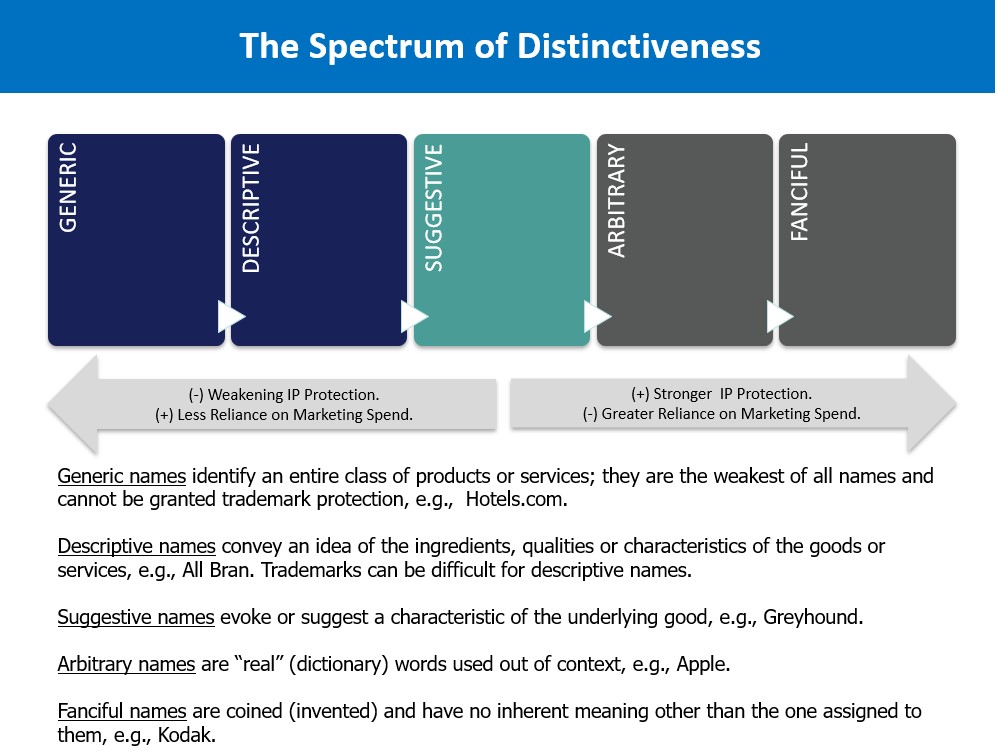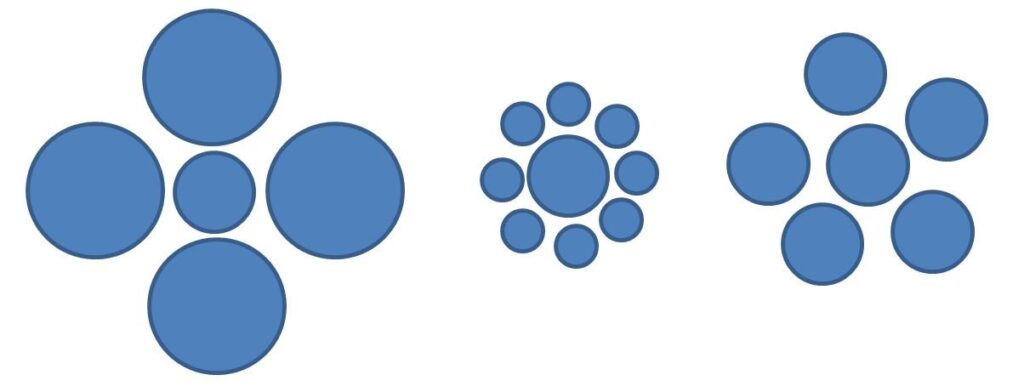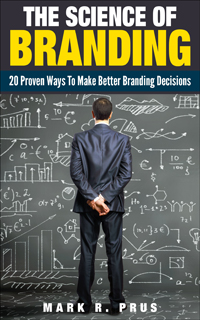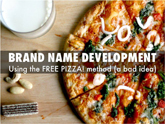What Type of Name Do You Want?
Name generation is easier if you decide on the type of name you want before you start developing names

Source: Author All Rights Reserved
Before you start thinking about a new name for your business, product, or service, you should pause and think about what type of name you want. I developed the chart above in conjunction with a trademark attorney. It classifies names into 5 different categories and notes the trademark strength of each (trademark strength improves from left to right) . Let’s examine the categories (from left to right).
GENERIC NAMES
Generic names are not ownable. They are not trademarkable. They offer no real insight into what your product can do. In short, generic names are useless. And yet many entrepreneurs want to develop generic names.
Stop it please. I understand that a generic name like Hotels.com communicates a class of products/services, and therefore seemingly implies ownership of that class of products/services. In reality, the opposite is true.
Consider the efforts brands like Kleenex or Band-Aid or even Google undertake to avoid becoming generic names that indicate a category. The reason they do this is simple: If you become generic, you lose the trademark. Here are a few examples of brand names that have lost their trademarks because they became generic: linoleum, cellophane, zipper, trampoline, dumpster, escalator, laundromat, and even aspirin were all once trademarked product names that have become generic names.
Never seek a generic name!
DESCRIPTIVE NAMES
One step up the trademark scale are descriptive names. Sometimes trademarks are possible for descriptive names. Sometimes they are not. Unfortunately, there is no clear-cut rule to clarify this dilemma. But I have seen many descriptive names get bounced by the US Trademark Office.
Entrepreneurs love descriptive names. The main reason is entrepreneurs feel that having a name that describes what the product is or what it does is like getting free advertising. And that may be true. Unfortunately, most of the other entrepreneurs in your space had the same idea.
Here is an example. If you have developed a new food chopping device that enables you to chop food into smaller pieces faster, then you may want to name this product “Fast Chop” because “fast chopping” is the main benefit of the product. In doing so, you may believe that you will save money on advertising because every package of the product is a descriptive billboard that communicates the main product benefit!
Unfortunately, you may be failing to consider that the competitive set consists of products called EZ Chop, Speed Chop, QuickChop, TurboChop, etc. Nobody is going to notice your “Fast Chop” product even if the name is prominent on the package. Any advertising that is done will be wasted as well. Consumers may think the product is great, but when they get to the shelf, they will be confused by all the similar names and similar products.
Is a descriptive name a good idea? Possibly. Here is how I would decide. Get the names of up to 10 competitors of your product. Then place them on the graphic of the spectrum presented at the beginning. If your competition clusters around descriptive names, then you should avoid that area because you will never stand out versus the competition. If, on the other hand, your competition is concentrated in the fanciful or coined names area, a descriptive name might be welcomed by your target audience.
SUGGESTIVE NAMES
I’ll admit I’m biased, but I consider suggestive names to be the trademark sweet spot. They are usually trademarkable. They often suggest some benefits of your product or service. They have the potential to be differentiated against the competition.
And they can become quite powerful brand names. Consider these examples:
· Twitter — The dictionary defines Twitter as: A light, but frequent chatter from birds. Isn’t that a perfect name for a social media network designed to encourage brief conversation? (BTW don’t get me started on the switch to X!).
· Dove — Dove: A delicate bird with a soft cooing call. A perfect name for a gentle skin care line?
· Pampers — Pamper: Indulge every comfort and kindness. Isn’t that perfect for your baby?
The reason I like suggestive names is they create a “mind puzzle” with your branding. When the name is somewhat ambiguous, the customer will then have to find a way to make the connection between the name and the product. Often the customer will spend time trying to figure out why the name was chosen, which can lead to higher recall of the name later and positive attributions to the product. If you use a slightly ambiguous name, the consumer might actually enjoy the “mind puzzle” and won’t have to work too hard to get your point. When consumers solve the puzzle, they will then have a sense of accomplishment because they were able to figure it out.
ARBITRARY NAMES
Arbitrary names are another wonderful option. In this case you use a real word but use it out of context. Examples include Apple, Nike, and Amazon. In each case, the name is a real word that can be found in the dictionary, but the intended meaning of the brand name is different from the dictionary meaning.
They are a little more subtle than a suggestive name. A suggestive name’s meaning is closely aligned with a product benefit. An arbitrary name is not (although company founders often rationalize the name choice with a far-fetched story). Steve Jobs named the company Apple because he liked the fruit. Later, a backstory was developed to suggest the name Apple was a good fit for the brand positioning because Apple products are “fun, spirited and not intimidating.”
Arbitrary names require additional advertising and PR support to establish the linkage to product benefits. But in the end, they can be very strong brand names.
FANCIFUL NAMES
Fanciful names are the trademark attorney’s dream date and the marketer’s nightmare.
Names that are made up (like Exxon, Kodak, or Pixar) are the easiest to get trademarked because they have little competition. But they are a marketer’s nightmare because they require a substantial investment to generate meaning.
As a name developer, I love the freedom that fanciful names allow. But honestly, they are usually a difficult sale to a client (unless of course the client thought of it first!). Trying to convince a CEO that a random name makes sense for the product is never easy. And consumer testing of fanciful names is particularly frustrating because consumers have no context for the name and often rank fanciful names well below more traditional choices.
Despite the shortcomings, if you have the opportunity to launch a breakthrough fanciful name you can be perceived as innovative and forward thinking. If your situation allows fanciful names, you should consider them!
SUMMARY
In reality, 4 out of 5 of these categories of names will work (please say no to generic names). Obviously, you may have a personal preference for one category and if you want that type of name then go for it! Just be careful about the influence of existing competitive names.
Here is a visual way to demonstrate the competitive issue. In the three groups of circles shown below, the circle in the center is always the same size. However, as you can see, the center circle looks smaller or larger based upon the size of the other circles surrounding it. The group of circles on the right has six similarly sized circles, and you can see how it is impossible to distinguish one from another. It is far better to be the outlier, such as the center circle in the first two groups of circles.

Don’t be like the group of circles on the right. Make sure you choose the type of name that will help you stand out from your competitors.
Choose the type of name you want before you start brainstorming! It will make your task easier!



